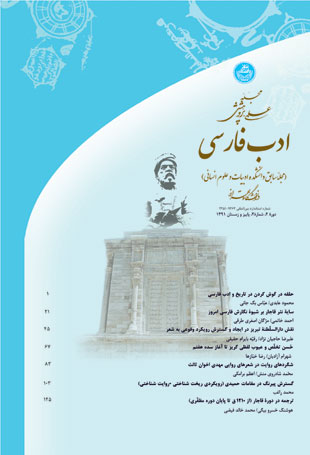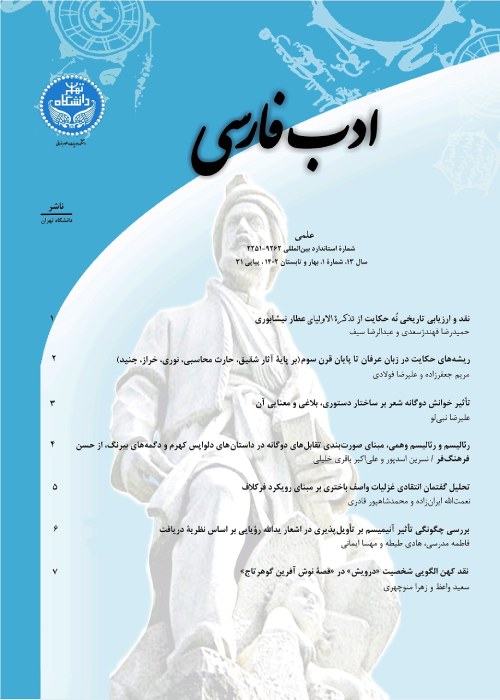فهرست مطالب

نشریه ادب فارسی
سال دوم شماره 2 (پیاپی 10، پاییز و زمستان 1391)
- تاریخ انتشار: 1391/12/12
- تعداد عناوین: 7
-
-
صفحه 1«حلقه در گوش کردن» آیینی کهن است که در میان اقوام و گروه های مختلف اجتماعی، و برای مقاصد گوناگون معمول بوده است. بررسی ها نشان می دهد که از گذشته های دور، هم در گوش انسان ها و هم در گوش حیوانات حلقه می- کرده اند و هرچند گونه هایی از آن را به قصد زینت و آرایش به کار می برده اند، غالبا برای گروه های فرودست جامعه، نشانه غلامی و بردگی بوده است. نگارندگان در این مقاله، با تامل در پیشینه این آیین در طول تاریخ و استخراج شواهد و نمونه های متعدد آن از متون ادبی و تاریخی، کاربردها و معانی مختلف و تنوع جنس و شکل این حلقه ها را در عرصه تاریخ و ادب فارسی نشان داده اند.
کلیدواژگان: آیین، تاریخ و ادب فارسی، _ گوشواره، حلقه در گوش کردن، حلقه غلامی -
صفحه 21در این پژوهش، چهار متن را از میان نثرهای قاجار بدین شرح برگزیده ایم: ناسخ التواریخ اثر محمدتقی لسان الملک سپهر، مسالک المحسنین اثر عبدالرحیم تبریزی، مجمع الفصحا اثر رضاقلی خان هدایت و هزار و یک شب ترجمه عبداللطیف تسوجی تبریزی. سپس در آنها مهم ترین اشکال های نگارشی و ویرایشی را در حوزه های فعل، نشانه های جمع، واژه ها و ترکیبات، قید، حروف، مصدر، صفت بررسی کرد هایم و ادامه آنها را در نثر فارسی امروز نشان داد هایم. در پایان، مهم ترین مشکلات نگارشی نثر قاجار و ادامه آنها را در نثر فارسی امروز در حوزه های یادشده دسته بندی کرده ایم. فرضیه تحقیق آن است که نثر دوران قاجار، در عین ارزشمندی، مشکلات نگارشی و ویرایشی درخور توجهی دارد و ادامه این مسائل را در نثر فارسی امروز نیز به روشنی می توان دید. هدف ما از این پژوهش، آن است که مشکلات نگارشی و ویرایشی را در نثر فارسی امروز، ریشه یابی و نویسندگان را متوجه آنها کنیم تا اجازه ندهند این مسائل به نوشته هایشان راه یابد.
کلیدواژگان: ویرایش، نثر قاجار، سبک شناسی، نگارش -
صفحه 45مکتب وقوع به لحاظ تحولات سیاسی اجتماعی در پیوند با دو دوره تیموری به خصوص در نیمه دوم قرن نهم و دوره صفوی است. این سبک از اوایل قرن دهم آغاز شد و در اواسط همان قرن رشد کرد و تا ربع اول قرن یازدهم ادامه یافت. درخصوص اشعار مکتب وقوع و تحلیل محتوای آن مباحثی پراکنده گفته شده است، اما درمورد خاستگاه جغرافیایی آن، تاجایی که مولفان جستجو کرده اند، هیچ بحث جدیی مطرح نشده است. نویسندگان در این مقاله کوشیده اند با توجه به حضور پیشاهنگان مکتب وقوع در آذربایجان و متعاقبا تحول در عرصه نقاشی مکتب تبریز، به نقش دارالسلطنه تبریز در پذیرش و بالندگی نگاه های آفاقی در عرصه هنر و ادبیات بپردازند.
کلیدواژگان: مکتب نقاشی تبریز، کمال الدین بهزاد، شهیدی قمی، تبریز، خلاصهالاشعار، لسانی، مکتب وقوع -
صفحه 67در بیشتر کتاب های بدیع فارسی و عربی، در بحث حسن تخلص، به برخی از آنچه گریز به ستایش را می آراید و آنچه موجب زشتی آن می شود، اشاره هایی شده و نمونه هایی از گریز نیک آورده شده است. اما توجه به اصول فصاحت و بلاغت، همچنین مجموعه شرایط ستایش نامه ها و نمونه های گریز استادان ستایش سرایی در ادب فارسی، نکات بیشتری را در این باره روشن می سازد.
نوشته پیش روی، پس از بررسی ستایش نامه های فارسی و آرای بدیعیان و ناقدان عرب و ایرانی، به اصول گریز نیک می پردازد و برای نخستین بار، بیش از سی نمونه زشتی گریز را تا آغاز سده هفتم، همراه با تبیین هفت عیب لفظی آنهاکلیدواژگان: گریز نیک، اقتضاب، گریز تک بیتی، _ زشتی گریز، اطناب در گریز -
صفحه 83از مهم ترین ویژگی های شعر مهدی اخوان ثالث (1307-1369) روایی بودن آنهاست؛ اما آنچه به شعرهای روایی او برجستگی ویژه ای می بخشد و آن را از آثار شاعران معاصرش متمایز می سازد، شیوه ها و شگردهای او در روایت است. وی در شعر از عنصر روایت به گونه ای خاص استفاده کرده است که با وجود نقش برجسته بسیاری از شگرد (=تکنیک) ها، ساختار روایی شعر هرگز لطمه ای به جوهر شعر نمی زند. به عبارت دیگر، در آثار او بیش از آنکه شعر در خدمت روایت داستانی قرار گرفته باشد، عناصر داستانی و روایی به خدمت شعر درآمده اند. این مقاله به بررسی و تحلیل شگردهای روایت شامل: شخصیت پردازی، گفت وگو، توصیف، فضاسازی، شیوه آغاز روایت ها، شیوه های بیان نمایشی، نقطه اوج و فرود، مرحله گذار در منظومه های روایی اخوان ثالث می پردازد و کارکرد ویژه هر یک را در شعر او نشان می دهد.
کلیدواژگان: شگرد های داستان پردازی، شعر روایی، مهدی اخوان ثالث، راوی -
صفحه 103در این مقاله، 21 مقامه از مقامات حمیدی (تالیف 551 ق) قاضی حمیدالدین بلخی (فو 559 ق) بررسی شده، اما مطالعه دو مقامه شش و چهارده به دلیل تمایزات آشکار ساختار پیرنگ با سایران، به آینده موکول شده است. ساختار پیرنگ هر مقامه، شامل ده کارکرد است که با افزایش و کاهش در آن گسترش می یابد. در واقع هدف اصلی این مقاله، بیان تعریفی منسجم از قواعد نوع ادبی مقامه در ادبیات فارسی است. رویکرد مورد نظر در این پژوهش، برگرفته از دیدگاه ولادیمیر پراپ (1895-1970 م) در ریخت شناسی قصه های پریان (1928 م) و پیوند آن با آموزه های روایت شناسی است.
کلیدواژگان: راوی، روایت شناسی، نوع ادبی، کارکرد، مقامه، پیرنگ -
صفحه 125بخشی از پیشینه ادبی و تاریخی ایران، در آثاری به جای مانده که حاصل ترجمه و یا اقتباس از متون مکتوب به زبان های دیگر است. این ترجمه ها را «میرزا»های مسلط به زبان و ادبیات فارسی انجام می دادند. سبک نگارش این آثار همان سبک نگارش دوره زمانی ترجمه است. دوره قاجاریه از مهم ترین دوره های ترجمه در تاریخ ایران از زبان فرانسوی و انگلیسی است.
هدف این مقاله، بررسی و ارزیابی نقش و جایگاه ترجمه از زبان انگلیسی به زبان فارسی، در مقایسه با زبان فرانسوی، در بخشی از دوره قاجار است.
در این پژوهش، ضمن بررسی تاریخ ترجمه از زبان انگلیسی به فارسی، با اتکا به تعداد آثار ترجمه شده و تعداد مترجمان دارالترجمه ناصری، پیشی گرفتن زبان فرانسه از زبان انگلیسی نشان داده، و زمینه ها و عوامل این امر شناسایی و بررسی شده است.
کلیدواژگان: زبان فرانسوی، زبان انگلیسی، زبان فارسی، ناصرالدین شاه، تاریخ ترجمه، قاجاریه
-
Page 1“Ear-ring wearing " is an ancient ritual that was common among folks and different social groups, and was done for various purposes. It has been shown in the studies that both humans and animals were being worn ear-ring from longs ago. Although some kinds of them were used as an adornment or makeup tool, but the ear-rings were mostly considered as a sign of slavery. Contemplating on the historical background of such ritual and utilizing several samples out of literary and historical texts, the authors of present article try to explain the usage, the meaning and the shape of ear-rings throughout Persian history and literature.Keywords: Earrings, Ear, ring wearing, Slavery Ring, Persian History, literature, Ritual
-
Page 21In present research, four of Qajar prose works were initially selected as following: Nasekh al-Tavarikh of Muhammad Taghi Lesan al-Molk Sepehr, Masalek al-Mohsenin of ‘Abd al-Rahim Tabrizi, Majma’ al-Fosaha of Reza Gholi Khan Hedayat, and Hezar-o-yek Shab translated by ‘Abd al-Latif Tasuji Tabrizi. Their most important writing and editing errors such as verbs, plural signs, words and structures, adverbs, conjunctions, infinitives and adjectives and their continuation up to contemporary Persian prose were shown and analyzed to be classified in different categories at last. The research hypothesis is that Qajar prose, despite of its productivity and worth, has many remarkable writing and editing errors, and we can easily see the continuation of these problems in Persian contemporary prose. We intend, in this article, to trace the writing and editing problems of Persian contemporary prose and convince the writers to stop such errors being penetrated in their own works.Keywords: Stylistics, editing, writing, Qajar prose
-
Page 45The Voquea literary School is strongly associated to the periods of Timurids – especially 2nd half of 15th century – and Safavids from the view of social-political points. The school was founded in the last 15th century and reached its maturity by the end of that century to be continued up to the early 16th century. There have been several sporadic discussions about the poems of Voquea School and their content analysis, but any discussion – as far as the authors have searched- has accomplished about its geographical origin. Concerning the attendance of scouters of Voquea School in Azerbaijan and then the evolutions occurred in Painting field of Tabriz School, the authors of present article have tried to evaluate the role of Dar al-Saltana of Tabriz in adaptation and development of supernatural regards in the fields of Art and LiteratureKeywords: Kamal al Din Behzad., Shahidi, e Qomi, Kholasat al Ashaar, The Voquea School, Lesani, Tabriz, the Paintin School of Tabriz
-
Page 67There are some comments and examples on the qualities that make a panegyric apt-transition a good-one or a bad-one in Arabic and Persian rhetoric books. But a deeper look on the principles of rhetoric and the study of panegyric masters’ poems would lead us to get some more information about this subject. Analyzing some Persian panegyric poems and criticizing the opinions of the Persian and Arabic rhetoricians, this article focuses on the principles of a well-made apt-transition and, for the first time, analyses about thirty examples of weak apt-transitions and reveals their verbal faults.Keywords: Persian poetry, panegyric poetry, apt, transition, ode., rhetoric
-
Page 83Narrative style is the main feature of Mehdi Akhavan Sales (1928-1990), one of the famous contemporary Persian poets. But what gives a special prominence to his narrative poems and makes it distinct from the works of other contemporary poets is his idiosyncratic use of narrative techniques and methods. He employed in his works the element of narration in a distinctive manner. Although, the narrative techniques mostly appear in his poems, they have been used in a way that they never distort the essence of his poems. In his works, techniques of narrative are at the service of the poetry, rather than the poetry being at the service of narrative. Characterization, dialogue, creation an ambiance/atmosphere, creation or using myths, applications of symbols and symbolic language are narration techniques being discussed, in this article, to indicate their special functions.Keywords: Mehdi Akhavan Sales, Narration Techniques., Narrator, Narrative Poetry
-
Page 103Twenty one Maqamas of Ghazi Hamid al-Din Balkhi’s (died in 559 A.H) work, by the name of Maqamat-e Hamidi (written in 551 A.H), are studied in present article. The study of 6th and 14th Maqamas is postponed because of obvious distinctions of plot structure with the other Maqamas. Each of Maqamas’ plot structure includes 10 functions and develops by increasing or decreasing of the functions. Indeed, the main purpose of this article is to offer a consistent definition of the genre (Maqama) rules in Persian literature. The present approach has been taken from the attitude of Vladimir Propp (1895-1970 A.D.) at Morphology of Fairy-tales (1928 A.D.) and notions of Narrative prose sciences.Keywords: Plot, Narrative science., Maqama, Function, Genre, Narrator
-
Page 125An important part of Iranian literary and historical background is remained in works had been translated or adopted from other texts written in other languages. They were done by translators, called “Mirzas”, who were masters in Persian literature. Their writing style was completely matched with the style of their period. Qajar’s era is considered as a prominent period in both French and English translation to Persian.This paper is going to study and evaluate the translation of English texts in to Persian and comparing it with texts translated from French in Qajar period. Surveying the history of English-Persian translation in Nasseri Translation center on the basis of some translations and translators, this article is to elucidate the reasons and factors of French surpassing to English in translation pieces.Keywords: French language, Persian language, Nasser al Din Shah, Qajar Dynasty, English language, History of translation


